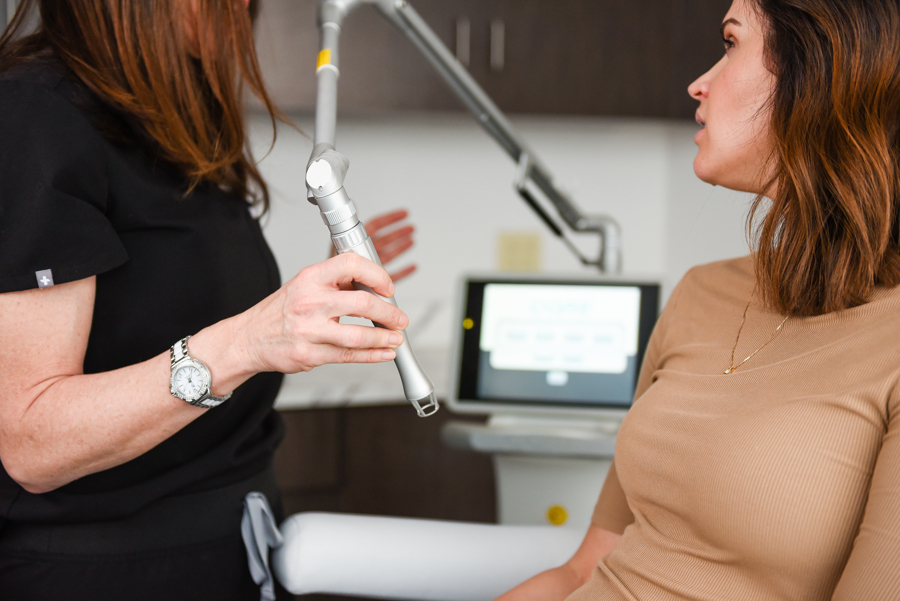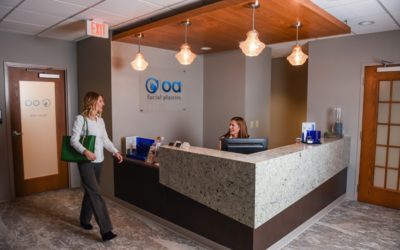Over the past few months on the blog, current technologies in skin rejuvenation to restore and maintain youthful, radiant skin have been highlighted including, noninvasive modalities (topical products, no downtime) and a spectrum of minimally invasive procedures (office-based, minimal downtime). Now that we are beyond summer and summertime sun exposure, fall through winter months are optimal for considering energy and chemical-based skin resurfacing techniques.
Skin Resurfacing Defined
Skin resurfacing is a broad term that encompasses a number of procedures including laser treatments, chemical peels, microneedling, and dermabrasion. Skin resurfacing takes advantage of natural healing mechanisms; by inducing a controlled injury, the procedure stimulates the body to create the building blocks of fresh, healthy skin.
The American Society of Plastic Surgeons published data in 2020 showing that laser resurfacing and chemical peels were the third and fourth most popular minimally invasive cosmetic procedures performed in the United States.
For all skin resurfacing procedures, skin type analysis is important when determining which procedure to prescribe. All procedures are not created equal for all skin types, some are unsafe to use for select skin types. There are also varying depths and types of treatments available that each treat a different concern, so your personal goals in seeking treatment are important to consider.
Choosing the correct treatment for your skin type and personal aesthetic goal minimizes complications and promotes great outcomes, so consultation with a physician is paramount in developing your treatment plan.
Laser Types: Non-ablative
“Non-ablative” describes lasers that avoid open injury to the skin. Rather they heat the dermis without causing damage to the outermost skin layer (or epidermis), stimulating the production of collagen and elastin in the dermal layer. Thus, the side effects and downtime are minimal, but with the caveat that the rejuvenating effect is slower and less pronounced than the results seen with an ablative treatment.
You may be interested in these treatments if you have mild wrinkles or discoloration. Here at OA Facial Plastics, we offer non-ablative services such as Laser Genesis as well as lightbased treatments with IPL and infrared light, Titan treatments with our esthetician team.
Laser Types: Ablative
“Ablative” treatments, on the other hand, heat both the epidermis and the superficial to mid dermal layers, removing the skin plagued by photoaging, discoloration, scarring, and fine wrinkles. New skin grows over the treatment area. Patients start to notice a reduction in fine lines and improvement in skin tone and texture as soon as the skin starts to heal after about 7 to 10 days post-procedure.
At OA Facial Plastics we offer ablative laser treatment with the CO2REⓇ laser. This laser is fractionated, which means that it doesn’t treat the entirety of the skin. Instead, the laser treats a fraction of the skin with each pass. It creates small columns of laser energy that pierce through the epidermis and dermis to target a precise depth, width, and temperature, leaving the skin between the columns untouched. Cells in the unaffected skin help to rapidly heal the laser treated area, creating a brand new skin layer with less side effects and downtime than a traditional fully ablative laser.
This treatment targets fine lines and wrinkles, skin spots or discoloration, and scarring. It is especially useful for treating wrinkles around the eyes and mouth. It may provide subtle improvements in skin laxity, but for patients who want to see definitive improvements in skin sagging (especially at the jawline) or upper neck, pairing this treatment with ProfoundⓇ Radiofrequency Microneedling during the same procedure visit will result in more comprehensive facial rejuvenation.
Chemical Based Peels
Chemical peels are agents that are applied to the skin to cause exfoliation. There are three different depths of chemical peels available: superficial, targeting the epidermis; medium, reaching deeper to the papillary dermis; and deep, which penetrates even further into the dermis. Deep peels have largely been replaced by laser skin resurfacing, but superficial peels have gained in popularity.
Chemical peels target different concerns based on their depth of penetration. For example, superficial peels improve mild abnormalities in the texture or color of the skin. Medium peels target fine, superficial wrinkles and discoloration. Deep peels are used for similar indications to ablative lasers like deeper wrinkles and scarring, but lasers have a better safety profile.
If you’d like to discuss a personalized skin rejuvenation regimen, click to request a consultation or call today: 317-708-6984.
FURTHER READING:
Tierney EP, Eisen RF, Hanke CW. Fractionated CO2 laser skin rejuvenation. Dermatol Ther. 2011;24(1):41-53. doi:10.1111/j.1529-8019.2010.01377.x
Alexiades-Armenakas MR, Dover JS, Arndt KA. The spectrum of laser skin resurfacing: nonablative, fractional, and ablative laser resurfacing. J Am Acad Dermatol. 2008;58(5):719-740. doi:10.1016/j.jaad.2008.01.003
Rahman Z, MacFalls H, Jiang K, et al. Fractional deep dermal ablation induces tissue tightening. Lasers Surg Med. 2009;41(2):78-86. doi:10.1002/lsm.20715
Kotlus BS. Dual-depth fractional carbon dioxide laser resurfacing for periocular rhytidosis. Dermatol Surg. 2010;36(5):623-628. doi:10.1111/j.1524-4725.2010.01516.x
Soleymani T, Lanoue J, Rahman Z. A Practical Approach to Chemical Peels: A Review of Fundamentals and Step-by-step Algorithmic Protocol for Treatment. J Clin Aesthet Dermatol. 2018;11(8):21-28.
American Society of Plastic Surgeons. “Plastic Surgery Statistics Report.” https://www.plasticsurgery.org/documents/News/Statistics/2020/plastic-surgery-statistics-full-report-2020.pdf. Published 2020. Accessed September 14, 2021.
Benefits of PRP Microneedling at OA Facial Plastics
Introducing PRP Microneedling Microneedling is a technique wherein tiny needles--less than 2 millimeters in length--are stamped or rolled over the skin to create micropunctures in the superficial skin layers. Microneedling has a long history of success in the...
“Zoom Boom” in Plastic Surgery: My FOX59 Interview
The pandemic has impacted all areas of our lives and, as we’ve reached the one-year point of spending more time at home and on-screen, Zoom work culture and video communication have people looking at their faces more than ever. Screen time leads us to critique our...
The Science of Skin Rejuvenation
As an Otolaryngologist (ENT) for nearly 20 years, I have been able to closely track and dive into the science of skin rejuvenation and treat my patients at the highest level. An ENT’s training encompasses more knowledge of the anatomy and physiology of the face, head,...




